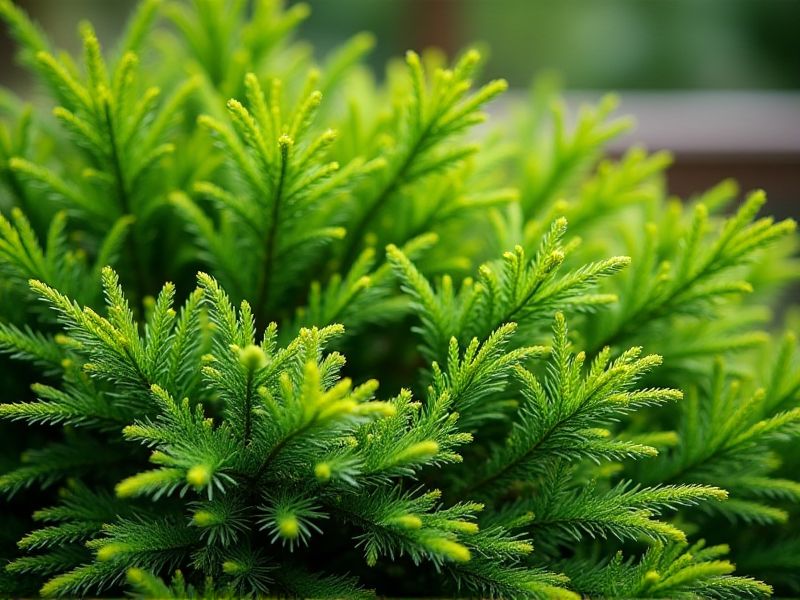
Evergreen landscaping plants, such as Boxwood (Buxus spp.), provide year-round greenery, making them ideal for hedges and borders. Pine trees, like Eastern White Pine (Pinus strobus), offer height and texture, thriving in various soil types and climates. Groundcovers like Creeping Juniper (Juniperus horizontalis) create dense foliage that suppresses weeds while enhancing the landscape's aesthetic. For a splash of color, consider planting Rhododendrons (Rhododendron spp.), which bloom vibrantly while maintaining their foliage through all seasons. Incorporating these evergreen plants into your garden design ensures a lush, vibrant outdoor space throughout the year.
List of some Landscaping plants that are evergreen
- Boxwood (Buxus sempervirens)
- Japanese Holly (Ilex crenata)
- Lavender (Lavandula)
- Rosemary (Salvia rosmarinus)
- American Arborvitae (Thuja occidentalis)
- Cherry Laurel (Prunus laurocerasus)
- Japanese Yew (Taxus cuspidata)
- Eastern Red Cedar (Juniperus virginiana)
- Dwarf Mugo Pine (Pinus mugo)
- Wintercreeper (Euonymus fortunei)
Important things about Landscaping plants that are evergreen
Year-Round Foliage
Evergreen landscaping plants provide year-round foliage, ensuring vibrant greenery even during winter months. Popular choices include boxwoods and hollies, which maintain their lush appearance throughout the seasons and serve as excellent hedges or focal points. Additionally, conifers like spruces and pines provide texture and height, while maintaining fascinating shapes. Incorporating a diverse selection of evergreen plants not only enhances your landscape aesthetics but also contributes to overall property value and environmental benefits, such as shade and habitat for wildlife.
Climate Adaptability
Evergreen landscaping plants are essential for creating a vibrant year-round landscape, as they retain their foliage and color in all seasons. Varieties such as Boxwood, Pine, and Holly not only provide visual interest but also serve as effective windbreaks and privacy screens, enhancing your outdoor space's functionality. These resilient plants are often drought-resistant and can thrive in various climates, making them ideal for sustainable landscaping. By incorporating evergreen species into your garden, you reduce maintenance needs while promoting biodiversity and soil stability.
Soil Requirements
Evergreen landscaping plants thrive in a variety of soil types, but they generally prefer well-draining soils rich in organic matter. A pH range of 6.0 to 7.5 is ideal for most evergreen species, allowing for optimal nutrient uptake. Incorporating compost or aged mulch not only improves soil structure but also enhances moisture retention, crucial for sustaining these plants year-round. When selecting evergreens for your landscape, consider the specific soil conditions of your yard to ensure healthy growth and longevity.
Growth Rates
Evergreen landscaping plants boast impressive growth rates and year-round foliage, making them ideal for enhancing the aesthetic appeal of your garden. Common evergreen species, such as Thuja occidentalis (Eastern Arborvitae) and Ilex crenata (Japanese Holly), typically exhibit rapid growth, often reaching 3 to 5 feet annually under optimal conditions. These plants not only provide dense foliage for privacy and windbreaks but also play a crucial role in soil stabilization and erosion control. When selecting evergreens for your landscaping project, consider factors like climate, soil type, and maintenance requirements to ensure healthy growth and longevity.
Watering Needs
Evergreen landscaping plants require consistent watering to thrive, especially during dry spells. It's important to water deeply and infrequently to encourage deep root growth, typically applying about one inch of water per week. Consider the specific needs of each variety, as some may tolerate drought better than others, such as Junipers and Hollies. Incorporating mulch around these plants can help retain soil moisture and reduce the frequency of watering, ensuring your evergreen landscape remains vibrant year-round.
Sunlight Preferences
Evergreen landscaping plants thrive in various sunlight conditions, making them versatile additions to your garden. Popular choices for full sun include the sturdy Eastern Red Cedar and the vibrant Boxwood, both offering year-round color and structure. If your garden receives partial shade, consider the hardy Japanese Holly or the graceful Cryptomeria, which can adapt while maintaining their lush foliage. For shaded areas, the glossy Green Mountain Boxwood stands out, ensuring your landscape remains lively even in less illuminated spaces.
Pest Resistance
Evergreen landscaping plants, such as holly, boxwood, and juniper, provide not only year-round visual appeal but also remarkable pest resistance. Many of these species have natural compounds that deter insects, minimizing the need for chemical treatments and ensuring a healthier garden ecosystem. Incorporating these resilient plants can enhance your landscape's aesthetic while reducing maintenance costs related to pest control. Selecting pest-resistant evergreens can lead to sustainable gardening practices that benefit both your outdoor space and the environment.
Pruning Techniques
Pruning evergreen landscaping plants involves removing dead, diseased, or unwanted branches to promote healthy growth and maintain their shape. Techniques such as thinning, heading back, and pinching help enhance air circulation and light penetration, which is essential for the plant's vitality. Always use sharp, clean tools to make precise cuts, minimizing stress on the plant and reducing risk of disease. Regular pruning not only keeps your evergreens aesthetically pleasing but also supports their longevity in your garden.
Nutrient Requirements
Evergreen landscaping plants, such as Boxwood and Holly, typically require balanced nutrients for optimal growth. Nitrogen is essential for promoting lush green foliage, while phosphorus supports root development and flowering. Potassium plays a crucial role in overall plant health, improving disease resistance and drought tolerance. Regular soil testing can help you determine specific nutrient needs, ensuring your evergreen plants thrive year-round.
Aesthetic Versatility
Evergreen landscaping plants, such as boxwood, holly, and juniper, provide year-round greenery and visual interest in gardens. These versatile species are favored for their ability to maintain lush foliage through every season, ensuring that your landscape remains vibrant even in winter months. The variety of textures and forms available--ranging from tall hedges to low ground covers--allows you to design a dynamic outdoor space that complements your aesthetic preferences. Incorporating evergreens not only enhances curb appeal but also serves as a backdrop for colorful flowering plants and seasonal decorations.
